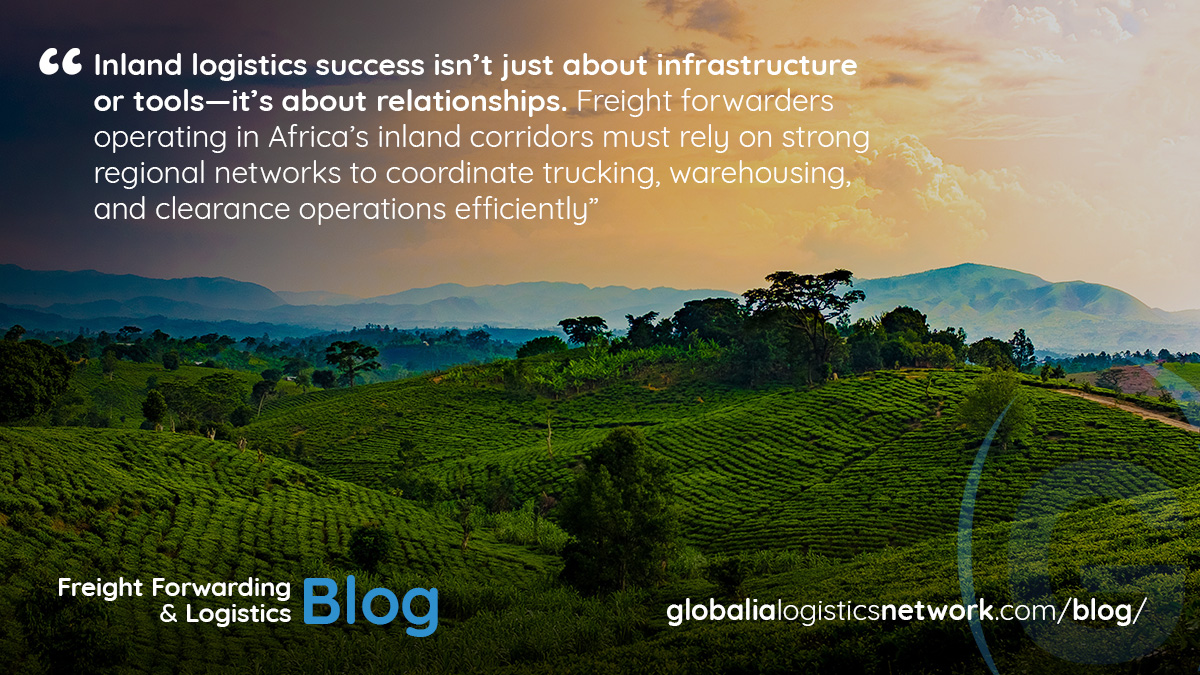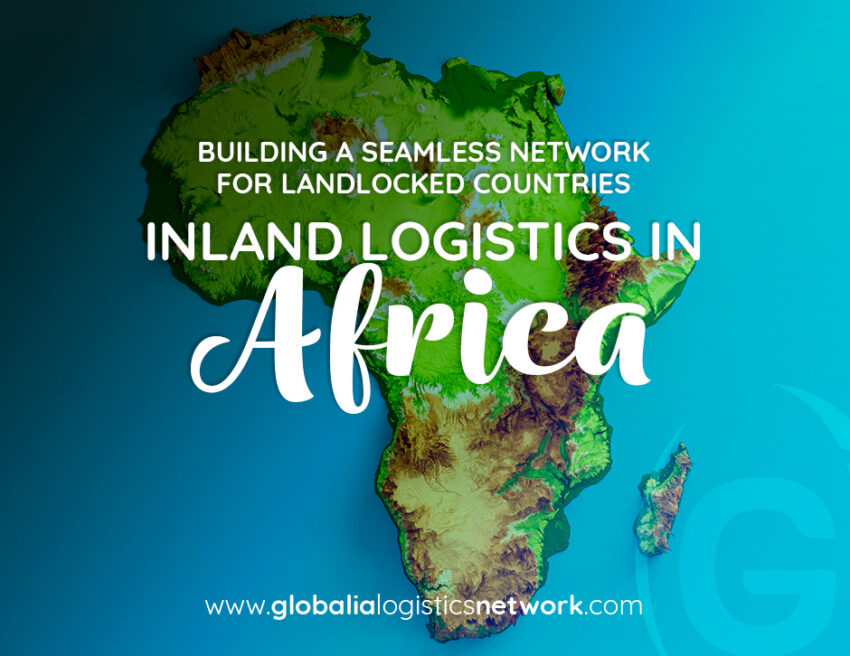When it comes to logistics in Africa, the spotlight often shines on bustling seaports like Mombasa, Durban, and Lagos. Yet, for the many landlocked nations scattered across the continent—from Mali and Niger to Uganda and Zambia—the true logistical challenge lies inland. Developing seamless, reliable inland logistics networks is no longer just a matter of economic convenience; it’s a foundational requirement for trade, growth, and regional integration. This is where freight forwarders in Africa are stepping in—not just as transport providers, but as architects of a better-connected continent.
As infrastructure investments, cross-border trade agreements, and digital platforms reshape the African logistics landscape, the race to improve inland connectivity is gaining momentum. For landlocked countries, access to efficient logistics corridors can make the difference between a 10-day supply chain and a 45-day bottleneck. From the rugged highways of the Sahel to the dense jungles of Central Africa, freight forwarders are navigating complex terrain—both literal and bureaucratic—to build stronger, smarter trade routes.

The inland challenge: Why landlocked countries struggle
Africa is home to 16 landlocked countries, many of which rely heavily on their coastal neighbors for import and export access. While ports are gateways to global markets, the journey inland is often fraught with logistical pain points: poor road conditions, limited rail networks, fragmented customs procedures, and underdeveloped border infrastructure.
For instance, it’s not uncommon for cargo moving from a port in West Africa to a landlocked country like Burkina Faso to spend more time at border crossings than in actual transit. The result? Delays, higher transportation costs, and lost opportunities for both importers and exporters. Without robust inland logistics systems, landlocked countries remain disconnected from regional and global supply chains—regardless of how efficient their coastal gateways are.
This is where freight forwarders in Africa have become indispensable players. Their deep understanding of terrain, regulation, and local partnerships enables them to coordinate and execute multi-modal inland logistics in even the most challenging environments.
Road and rail: The backbone of inland freight
Improving Africa’s road and rail infrastructure is central to overcoming the inland logistics dilemma. Projects like the North-South Corridor, the Trans-African Highway network, and the Lobito Corridor are gradually stitching together a continent where movement was once disjointed.
Freight forwarders are playing a crucial role in maximizing the utility of these corridors. In East Africa, for example, goods arriving at Mombasa Port often move inland via the Northern Corridor toward Uganda, Rwanda, and even South Sudan. In Southern Africa, the Beira and Nacala corridors provide lifelines to landlocked Malawi and Zimbabwe. Each corridor demands a unique logistics strategy, often involving road-rail combinations, warehousing solutions, and clearance at multiple checkpoints.
And while progress is evident, challenges persist: aging infrastructure, limited rail capacity, and political instability in some regions. Freight forwarders in Africa are rising to these challenges by creating multimodal solutions, leveraging regional integration efforts, and investing in last-mile delivery mechanisms to bridge infrastructure gaps.
Cross-border coordination and customs harmonization
The African logistics journey doesn’t stop at infrastructure—it runs through the bureaucracy of borders. Customs delays, inconsistent documentation requirements, and lack of coordination between neighboring countries often extend inland transport times drastically.
Fortunately, the African Continental Free Trade Area (AfCFTA) and regional bodies like the East African Community (EAC) and the Economic Community of West African States (ECOWAS) are pushing for harmonized customs procedures and streamlined clearance systems. One-stop border posts (OSBPs), such as those between Kenya and Uganda or Zimbabwe and Zambia, have significantly cut down crossing times.
Still, much work remains. Freight forwarders who operate successfully in inland Africa are those who understand the nuances of cross-border trade. They invest in skilled customs brokers, digital clearance tools, and close collaboration with local authorities to ensure paperwork doesn’t hold up shipments. In a world moving towards digital freight forwarding, these capabilities will only grow in importance.
Warehousing and distribution: The missing link in inland supply chains
Another major hurdle in inland logistics across Africa is the lack of adequate warehousing and distribution facilities. In many regions, once cargo arrives inland, there’s a shortage of secure, temperature-controlled, or purpose-built storage facilities—particularly for pharmaceuticals, perishables, and FMCG products.
Forward-thinking freight forwarders in Africa are filling this void by partnering with local investors and developers to establish strategically located logistics hubs near border towns, inland depots, and economic zones. These hubs don’t just store goods—they act as transloading points, consolidation centers, and customs processing zones, effectively decentralizing logistics from congested ports.
Furthermore, investment in cold chain infrastructure is allowing perishable goods to move deeper into the continent, opening new markets for agricultural exports and pharmaceutical imports.
The role of digital freight forwarding in inland Africa
Technology is rapidly changing how inland logistics is managed in Africa. The traditional image of paper-heavy, manually tracked shipments is giving way to real-time GPS tracking, automated customs declarations, and digital document sharing. For freight forwarders managing multi-country inland routes, these tools are game changers.
Digital freight forwarding platforms help streamline complex inland operations by offering route optimization, delivery status updates, and proactive risk alerts. They also enable better collaboration between forwarders, clients, and government agencies by ensuring transparency and data consistency across borders.
Mobile platforms, in particular, are proving crucial in remote areas where internet connectivity is limited but mobile penetration is high. Drivers, warehouse managers, and customs agents can communicate through SMS- or app-based systems, cutting down on delays and errors.
For landlocked countries, this digital leap is critical. It reduces the reliance on physical presence, minimizes manual errors, and ensures a level of control and predictability that was previously unavailable. And for freight forwarders in Africa, embracing digitalization is no longer optional—it’s a competitive necessity.
Freight forwarding networks: Unlocking regional synergies
Inland logistics success isn’t just about infrastructure or tools—it’s about relationships. Freight forwarders operating in Africa’s inland corridors must rely on strong regional networks to coordinate trucking, warehousing, and clearance operations efficiently. This is where membership in global freight forwarding networks like Globalia Logistics Network becomes a significant asset.
With vetted members in strategic locations across Africa, Globalia enables forwarders to collaborate with trusted partners who share a commitment to service standards, payment security, and digitalization. The network provides access to FreightViewer, Globalia’s own freight quotation platform that helps members generate professional quotes quickly, even for complex inland routes. In the context of inland logistics, where costs and transit times vary significantly, this tool allows forwarders to offer clients real-time, competitive, and transparent pricing.
By combining local expertise with global support, freight forwarders in Africa who are part of such networks are better positioned to build resilient inland corridors, win regional contracts, and serve high-value clients with consistency and reliability.


